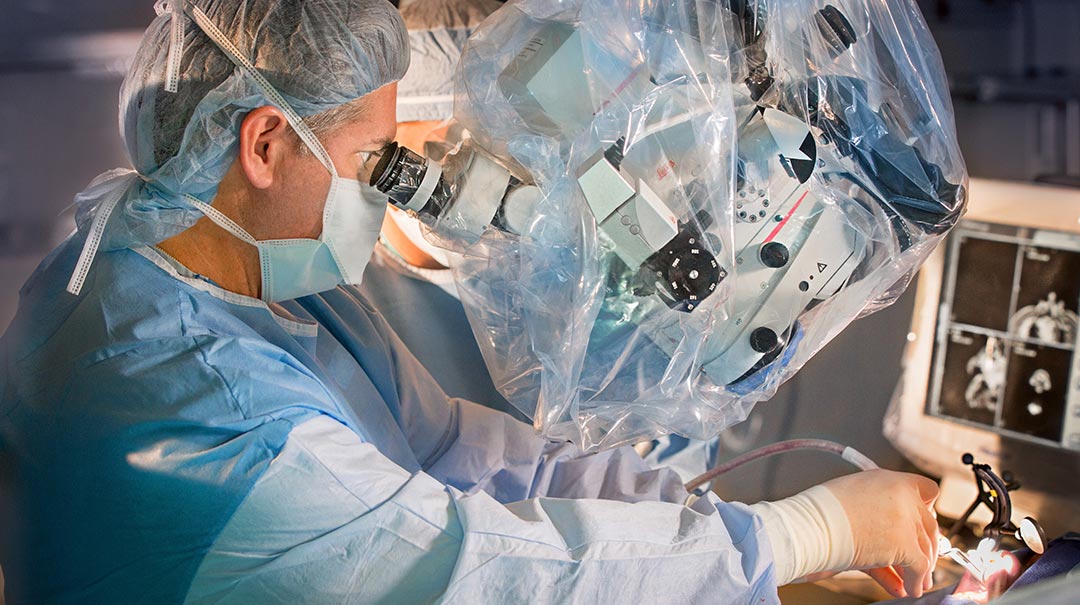Find care now
If you are experiencing a medical emergency, please call 911 or seek care at an emergency room.

Imagine this scenario: You come to the hospital with a complex neurological condition, and your surgeon uses a device or instrument you’ve never seen before—a tool that is perfectly designed to approach your delicate or complicated surgical need. If it sounds futuristic, think again. This scene plays out daily in our neurosurgery department due to innovative creations from our Center for Image-Guided Neuro-Integrative Surgery, or CIGNIS.
At CIGNIS, the brightest minds in neuroscience and engineering join forces to refine treatments and instruments to navigate neurological care. CIGNIS scientists not only improve existing tools but also design novel instruments and therapies to treat even the most complex conditions.
Streamlined Scientific Solutions
The CIGNIS spirit of collaboration often leads us to work alongside equipment manufacturers such as K2M, a company that designs and creates many of our surgical products. MedStar Washington Hospital Center is a K2M alpha site for innovation, which means we help them test and refine the most advanced equipment before it’s available to everyone else.
For example, we are the first hospital in the Washington, D.C., area to have the Airo Mobile Intraoperative CT system, which lets us perform high-definition CT (computed tomography) scans in real time during neurosurgery. Our doctors worked closely with K2M and its partner, Brainlab, to provide input that influenced the Airo system’s design and software.
Our collaboration with K2M is a two-way street. I might realize after a surgery that a procedure could be better or more efficient with a new or different tool. Next, I describe the need to an engineer, who determines whether it’s possible to create such a device and, if so, develops a prototype.
Likewise, the engineers often watch us in surgery while we use the tools and get our feedback on improvements we’d like to see. For example, all our tools and software for intraoperative angiography, a procedure that lets us see inside the blood vessels of the brain during neurosurgery, have been revamped based on the feedback we gave the K2M engineers. We also collaborate to create unique solutions, such as implants designed for a single patient and constructed with a 3D printer to fit the patient’s anatomy exactly.
Benefits for Patients and Neurosurgeons
Refining the tools and techniques we use for neurosurgery pays huge dividends for patients and doctors alike. More of our surgeries are being done with a minimally invasive approach, which means smaller incisions and faster recoveries for patients. These procedures require extremely precise instruments, and we are constantly refining these instruments to improve patient care and surgical accuracy.
Better surgical equipment means our surgeries also take less time. Some surgeries that used to take eight hours now only take four, which means patients can begin recovery sooner. Precise, minimally invasive surgeries offer our patients better outcomes and a lower risk of needing more surgeries down the road.
Pushing the Boundaries of Neuroscience
We have been developing CIGNIS here at MedStar Washington Hospital Center for a long time, and I’m not aware of another hospital that has a program quite like ours.
However, we are spreading the word of our success to our colleagues. We regularly train doctors from around the world on how to use the cutting-edge tools and technologies we help create. I’m hopeful that they institute similar programs at their organizations to benefit more patients worldwide.
A whole squadron of professionals is involved when we perform neurosurgery—even experts who never scrub up or put on surgical gowns. CIGNIS helps us bolster the talents of these amazing people and shape the course of neurosurgery for decades to come. I can’t wait to see where we go from here.














